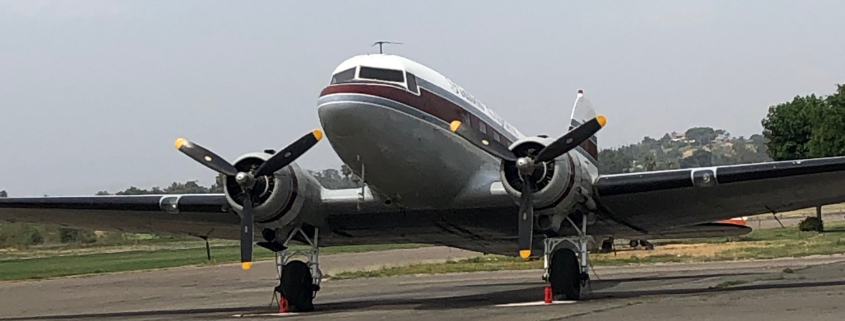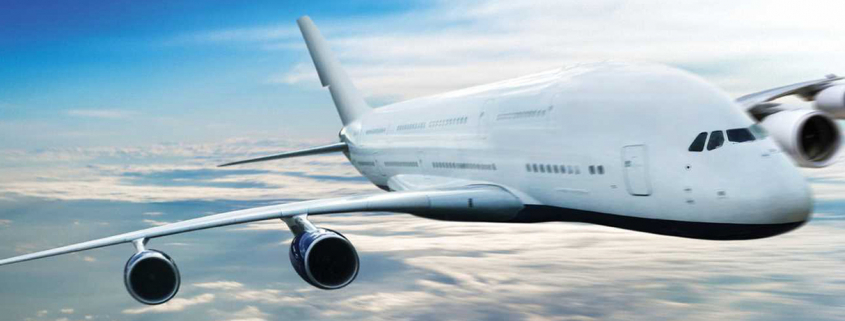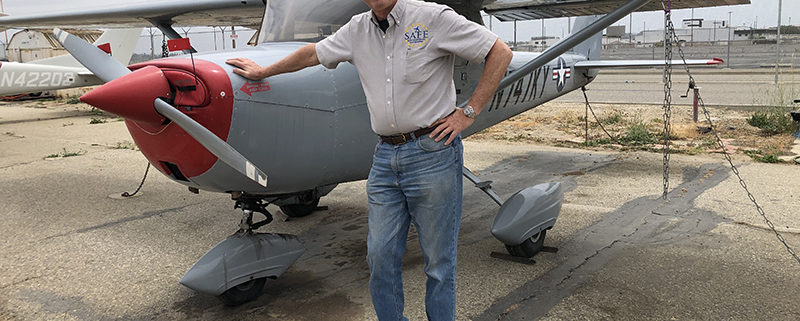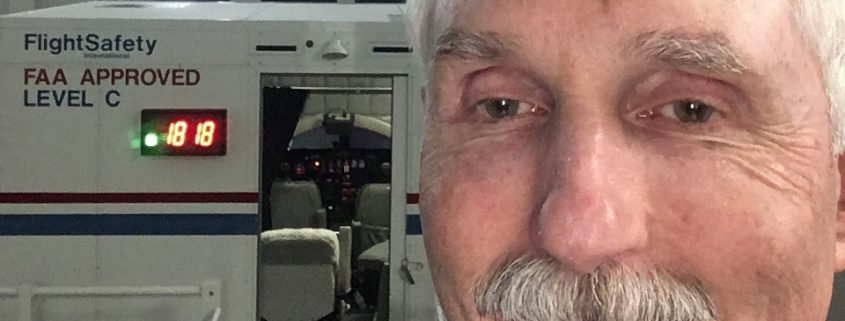Flying a DC-3, ‘Flabob Express’, almost…
/1 Comment/by John MahanyAfter a yummy breakfast at the Airport Café, with my training Captain and Instructor, Bob, and his brother Tim, both of whom are retired airline captains and are now DC-3 pilots, flying Flabob Express, we went out and inspected the airplane. We did a ‘preflight’ or ‘walkaround’ as we call it. They actually kidded me about my smart decision not to wear a white ‘T’ shirt, (who knew?) under my blue Chambray sport shirt, (I was wearing a grey T shirt) because with all of the oil, grease and grime in and around the wheel wells and the engines, some of it was bound to get on my T shirt.
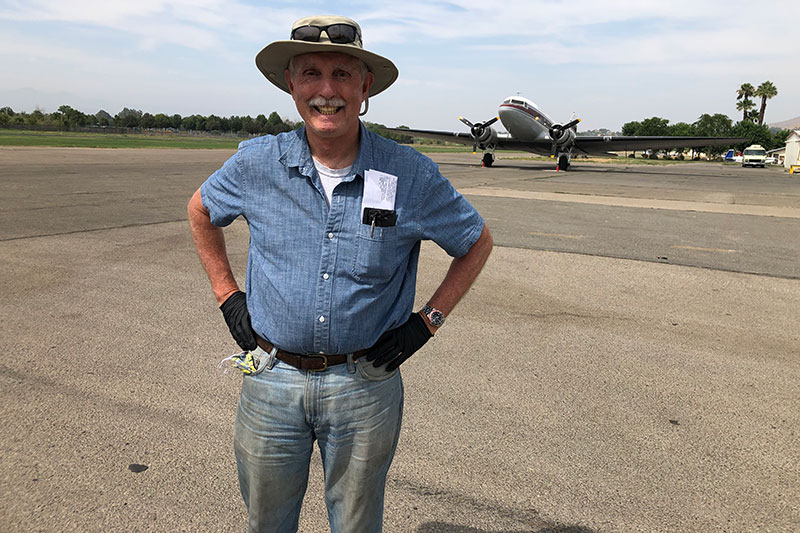 Aircraft with ‘radial’ engines, like the DC-3, are well known for leaking oil, not in flight, but rather on the ground, when parked. It’s just the way radial engines are. There’s usually an empty oil pan below each engine to catch the oil. And the DC-3 holds 29 gallons of oil. Remember, this airplane was designed and built back in the 1930’s. It’s pre-WWII. A much different time. So, a white ‘T’ shirt would quickly get dirty and show all the grease and oil stains! They told me I ‘passed’ the first test, not wearing a white T shirt! Yeah!!
Aircraft with ‘radial’ engines, like the DC-3, are well known for leaking oil, not in flight, but rather on the ground, when parked. It’s just the way radial engines are. There’s usually an empty oil pan below each engine to catch the oil. And the DC-3 holds 29 gallons of oil. Remember, this airplane was designed and built back in the 1930’s. It’s pre-WWII. A much different time. So, a white ‘T’ shirt would quickly get dirty and show all the grease and oil stains! They told me I ‘passed’ the first test, not wearing a white T shirt! Yeah!!
You actually have to duck down and then carefully walk into the wheel wells, where there is a lot of stand-up headroom, and avoid bumping your head ‘ouch!’ on the oil cooler (which is directly in front of the wheel well, and is below the engine, in the slipstream) to accomplish some of the pre-flight tasks.
After this, we went back inside to an air-conditioned conference room and Bob used a PowerPoint presentation about the airplane as a point of reference, to discuss the systems. We also of course discussed flying the DC-3, various power-settings, configurations, how it handled, and how things generally work, for about 2 hours. They had sent me a manual in advance, which I had read through.
The airport we are flying out of is called Flabob Airport (KRIR), and is about 40 miles east of Long Beach, in Riverside, CA, aka the ‘inland empire’ in SoCal. It was renamed ‘Flabob’ Airport in 1943 by Flavio Madariaga and Bob Bogan, so as to avoid any confusion with the other airport in Riverside. The name of the airport was derived by combining the first three letters of their first names.
Flabob is a small airport, with one hard-surfaced runway, 3,200’ long, and is typically not very busy, thus no need for a control tower. It also has a nicely maintained grass runway, which is rare anymore, parallel to the hard-surfaced runway, for use by single engine airplanes if they so desire. Their insurance requires that they have 2 qualified pilots in the pilot’s seats when flying into or out of Flabob.
Since I’m being trained, and am not yet ‘qualified’, I was standing right behind them, in the cockpit, where a small ‘jumpseat’ would normally be, typically for training, or a ‘deadheading’ pilot or FAA Inspector, except that this DC-3 does not have a jumpseat. So I was holding on, watching them, with my headset plugged in so I can hear their communications via the intercom, and know what’s going on.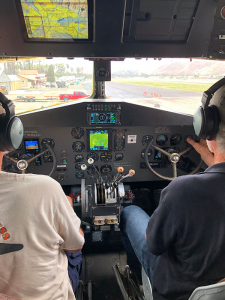
The plan was for us to takeoff out of Flabob, and then, when at a safe altitude, above say, 2,500’ feet, the co-pilot, Tim, and I would change places. Simple. He’d get out of the co-pilot seat and go take a seat back in the cabin, and I’d get in the co-pilot seat…buckle up, and FLY!! We’d then go through all of the required maneuvers, takeoffs and landings, for me to become qualified as a DC-3 co-pilot!
We finally got around to starting engines, and with radial engines, this is quite a busy process! It’s a 2-man (person?) process. This is old technology. Typical of many airliners, on an overhead panel, there are toggle switches for turning various components on/off, and among them are spring-loaded starter switches.
During the process of starting engines, one of the pilots is looking out of the open left or right-side cockpit windows and watching and counting OUTLOUD the propeller blades (1,2,3,4,5,6 etc.) as they pass by the window, so the other pilot can hear him, as the 3 bladed propellers start slowly turning through their arcs.
As your count reaches ‘6’ blades you turn on the primer switch, adding fuel, and shortly after that, at ‘9’ blades, you turn on the magneto switch, to get ‘ignition’, then combustion, and as it starts, then on the center ‘quadrant’, move the mixture lever out of ‘idle cut-off’ to the auto-rich position, and advance the throttle slightly, as needed, and hopefully it starts. Radial engines can be cantankerous. They don’t always start on cue. Then the Pratt & Whitney 1830 (2 rows of 7 cylinders), each capable of producing 1,200Hp, loudly rumbles to life, belching blue exhaust smoke and making quite a ruckus!! Then checking the other engine instruments for proper after-start indications; oil, fuel, hydraulic and vacuum pressures on their respective gauges, and then repeat for the other side.
After the engines have warmed up enough, with the oil temperatures reaching 40° and cylinder head temperatures reaching 100°, and the ‘after- start’ checklist is completed, and the crew is ready to taxi, the parking brake is released, power is slowly applied, and we start to taxi. Carefully.
This can be tricky, as the brakes must be used, but sparingly because they can heat up quickly, and the tail wheel is ‘free-castering’, meaning it can swivel 360°, or it can be locked straight (for takeoff and landing). The wings on a DC-3 are 95’, very long! They are 30’ longer than the fuselage, which is only about 65’ long. With such a wide wingspan, you have to be very careful when maneuvering on the ground to make sure the wingtips are clear of any obstacles.
It took several minutes slowly taxiing down a narrow taxiway to get to the run-up area adjacent to runway 24 at Flabob. After finally completing the run-up, and announcing our intentions on the Unicom frequency, we finally got lined up on the runway. Bob added power for takeoff, and we were just starting to roll, when the right engine suddenly started to act up. Strangely, it did not develop full power, and the right tachometer (RPM) began fluctuating. This is not good. Hmm. So, Bob, who was in the left seat, immediately pulled the throttles back to idle and applied the brakes, and ‘rejected’ the takeoff. It was the only thing to do. No time for analysis. Just ‘abort’ the takeoff.
Just like airline ‘standard operating procedures/SOP’s’. We then taxied the remaining length of the runway, turned right, and taxied clear of the runway, and then turned right again, onto another taxiway, and then shut down, and secured the aircraft. A small ground crew came out to meet us, including the mechanic. And much discussion ensued.
We were of course surprised, because we had no reason to expect anything, but we had ‘briefed’ or discussed this possibility beforehand (every takeoff is briefed), and they handled it in a professional manner. We are not sure yet what happened. They will inspect the engine. I will have to return at later date to do the flying…and complete the training.
Of course, I am disappointed that we did not takeoff and I did not get to fly, but from a professional standpoint, I have learned long ago to take these things in stride. ‘Stuff happens’ as we say. Today, it happened, they handled it appropriately, and we go from there. I learned a lot, and I have a much better understanding of the DC-3, and technology from the 1930’s. “it’s all good’, as we say. Lessons learned. Bob and his brother, Tim, were excellent to work with. I’m looking forward to my next training flight in the DC-3!
Fly safely,
John
Do you know the difference between the FAR’s and AC’s?
/1 Comment/by John Mahany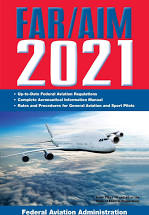 Do you know the difference? This is area of confusion among some pilots. The rules, that is, the Federal Aviation Regulations, aka the ‘F-A-Rs’ or ‘regs’, for short, spell out the many requirements that we follow, as pilots, mechanics, and air traffic controllers, to operate an aircraft safely, in the National Airspace System (NAS), and stay ‘in compliance’. The FAR’s are formal regulations that have been adopted by the FAA. They have been authorized by an Act of Congress.
Do you know the difference? This is area of confusion among some pilots. The rules, that is, the Federal Aviation Regulations, aka the ‘F-A-Rs’ or ‘regs’, for short, spell out the many requirements that we follow, as pilots, mechanics, and air traffic controllers, to operate an aircraft safely, in the National Airspace System (NAS), and stay ‘in compliance’. The FAR’s are formal regulations that have been adopted by the FAA. They have been authorized by an Act of Congress.
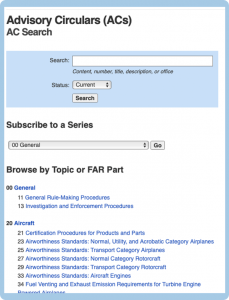 There is a saying that regulations are written in ‘blood’, because frequently, following an aircraft accident with fatalities, a new regulation emerges to address whatever happened. And there is a book that is issued every year, with the most up-to-date compilation of rules, and procedures. That is the ‘XXXX’ year FAR/AIM. It’s also available as an app, for your device. Every pilot should have a copy of this and refer to it as needed.
There is a saying that regulations are written in ‘blood’, because frequently, following an aircraft accident with fatalities, a new regulation emerges to address whatever happened. And there is a book that is issued every year, with the most up-to-date compilation of rules, and procedures. That is the ‘XXXX’ year FAR/AIM. It’s also available as an app, for your device. Every pilot should have a copy of this and refer to it as needed.
While we are on the topic, the AIM, or Aeronautical Information Manual, is a collection of information, best practices, and explanation of regulatory materials. Though the AIM is ‘not regulatory’, it does provide guidance on how to proceed with a given procedure. And sometimes, the guidance is the rule.
Then there are the FAA’s Advisory Circulars, or AC’s, for short. AC’s cover a wide range of topics, and are numbered accordingly. AC’s are typically non-regulatory. The FAA states this on its website when referring to a specific AC; “This AC is not mandatory and does not constitute a regulation. It is issued for guidance purposes and to outline a method of compliance with the rules.”
AC’s cover a wide range of topics, and are numbered from 00 through 211, but are not inclusive. For example;
AC 00 – General
AC 20 – Aircraft
AC 60 – Airmen
AC 70 – Airspace
Each of these has one or more subsections containing more specific guidance as applicable. From another source, “… Advisory Circulars are intended to be informative in nature and not regulatory; however, many times they describe actions or advice that the FAA expects to be implemented or followed.”
So, AC’s are typically non-regulatory guidance, and contain advice and methods of complying with FAA Regulations as they are written. They sometimes also provide additional explanatory materials.
I hope this helps to clear up some of the confusion regarding the difference between FAR’s and AC’s.
Fly safely!
John
The PHAK and the AFH
/1 Comment/by John MahanySomeone asked this recently on a FB page for student pilots; what’s the difference between “The Pilot’s Handbook of Aeronautical Knowledge”, or PHAK, and “The Airplane Flying Handbook”, or AFH? It’s a good question. Do you know? These books are complimentary. Each alone is not sufficient.
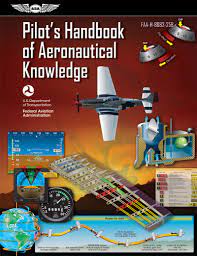 Generally speaking, the PHAK is ‘the big picture’. It was most recently updated by the FAA in 2016. It’s a broad overview of aviation knowledge that every pilot should know. It actually starts out with the first chapter being titled, ‘An introduction to flying’, appropriately enough. Then chapter 2 continues with Aeronautical Decision Making, or ADM, for short. This is especially important now. ADM is falls into another area called, ‘special emphasis’ items. Decades ago, this was overlooked. But after too many accidents, this has become especially important now, whether flying alone or as part of a crew. Following chapters then address the parts of an airplane, the principles of flight, discusses some basics of aviation weather, airport ops, and aeromedical factors.
Generally speaking, the PHAK is ‘the big picture’. It was most recently updated by the FAA in 2016. It’s a broad overview of aviation knowledge that every pilot should know. It actually starts out with the first chapter being titled, ‘An introduction to flying’, appropriately enough. Then chapter 2 continues with Aeronautical Decision Making, or ADM, for short. This is especially important now. ADM is falls into another area called, ‘special emphasis’ items. Decades ago, this was overlooked. But after too many accidents, this has become especially important now, whether flying alone or as part of a crew. Following chapters then address the parts of an airplane, the principles of flight, discusses some basics of aviation weather, airport ops, and aeromedical factors.
On the other hand, the “Airplane Flying Handbook” addresses the fundamentals of flying the airplane, and all that goes with that. Like the PHAK, it too was updated in 2016. Starting with the basics, like ground operations, flight maneuvers, stall spin awareness, and continues on up to transitioning to bigger aircraft, complex aircraft, multi-engine aircraft, tail wheel airplanes, and even to turboprops and jets. And now it also includes LSA, Light Sport Aircraft, at the other extreme.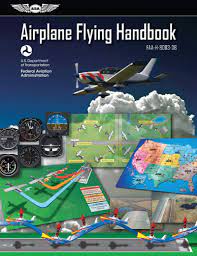
The material in both of these books, as it applies to single engine airplane operations, is important for a student pilot to know and understand. You don’t have to know about stepping up, or transitioning, as it is properly called, to bigger, complex aircraft yet. Take it one step at a time.
These books represent the FAA’s official policy on things aeronautical, and how an airplane is flown, throughout the phases of flight. These two handbooks compliment the other required training and reference materials that any student pilot will need to learn and understand, in the process of becoming a licensed pilot.
Fly safely,
John Mahany
Pilot weather briefings, VASI out of service, and globe-trotting aviators
/1 Comment/by John MahanyOn Saturday, April 24, 2021, on AOPA Live, it was reported that the FAA recently issued an Advisory Circular, AC 91-92, that addresses the “Pilot’s Guide to a Preflight Briefing’. With the widespread use of Smartphone’s, devices and online briefings, many pilots now ‘self-brief’. The FAA is addressing this, and this AC provides guidance to pilots on how to properly self-brief and do a proper risk assessment before flight, as well.
For more information CLICK HERE
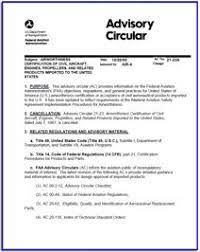 On Sunday, May 2, I flew to Corona Mun. Airport (KAJO) for low-priced avgas. When I was on final approach to runway (R/W) 25, I saw that the VASI was out of service. That’s strange, I thought. I later called the airport manager and left a message. He replied by text; “…Hey John, I got your voicemail regarding the VASI and I did notice that they were not operational this morning and I had called that in. Thank you and we do appreciate your diligence and reporting it.
On Sunday, May 2, I flew to Corona Mun. Airport (KAJO) for low-priced avgas. When I was on final approach to runway (R/W) 25, I saw that the VASI was out of service. That’s strange, I thought. I later called the airport manager and left a message. He replied by text; “…Hey John, I got your voicemail regarding the VASI and I did notice that they were not operational this morning and I had called that in. Thank you and we do appreciate your diligence and reporting it.
Curtis Showalter Airport Administrator”
Lesson: IF you fly into a non-towered airport and notice something wrong, please call the airport manager and tell him or her so they can take corrective action. I found the number on airnav.com.
Finally, a shout out to two intrepid, globe-trotting aviators, Adrian Eichhorn and Shinji Maeda, who on May 5, in each of their Beech Bonanza’s, took off from AOPA headquarters in Frederick, MD (KFDK). They were on respective record-setting flights. Adrian’s route was up north and over Canada to the North Pole, which he orbited, before proceeding to land in Fairbanks, AK. Shinji, who is the first Japanese, one-eyed pilot, and who is a US citizen, proceeded north and east, towards the North Atlantic and Europe, and is flying around the world, with many stops. His goal? Raise awareness of what you can achieve and inspire others to do the same. Do not let ‘limitations’ hold you back. Impressive! https://www.lightspeedaviation.com/polar-flight-2021/
The New CFI Corner
/1 Comment/by John Mahany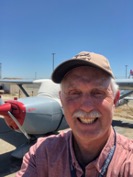 Welcome to my blog! Last year, on April 30, 2020, I was suddenly informed that my services as classroom and simulator instructor were no longer needed! I was initially surprised but quickly figured it out. My boss, the Center Manager at a large FAR 142 Learning Center, thanked me for my service (teaching pilots to fly jets, the Cessna Citation 2&5), and, told me that unfortunately, he had to let me go. I was one of many being cut. A corporate decision, made at headquarters, not his decision. ‘Separated’ is the word he used. Not terminated, not furloughed. Separated. Ok. A corporate, legal thing. I could reapply at some future date, whenever they start hiring again.
Welcome to my blog! Last year, on April 30, 2020, I was suddenly informed that my services as classroom and simulator instructor were no longer needed! I was initially surprised but quickly figured it out. My boss, the Center Manager at a large FAR 142 Learning Center, thanked me for my service (teaching pilots to fly jets, the Cessna Citation 2&5), and, told me that unfortunately, he had to let me go. I was one of many being cut. A corporate decision, made at headquarters, not his decision. ‘Separated’ is the word he used. Not terminated, not furloughed. Separated. Ok. A corporate, legal thing. I could reapply at some future date, whenever they start hiring again.
Looking back, due to the rapidly growing global pandemic that was suddenly affecting ALL of us, in 2020, in ways that we could not yet imagine. I was one of many victims of this. As a result, the FAA had implemented a new rule, last March, that extended the annual training requirements for pilot ‘currency’, as it’s called, for Part 91 pilots (corporate, not-for-hire), for an additional 90 days. But not for Part 121 (airline) or Part 135 (charter) pilots. So, many clients were cancelling or postponing their required training, for 90 days, or longer. Suddenly we had too many instructors, along with other support staff. I was one of them. Many staff at other Learning Centers were also let go.
What a year. For all of us. Was this the perfect storm? Who among us was ready for this? I sure wasn’t. Retirement? Hell no! I’m not ready for that. Who can afford to retire? I can’t. Besides, I have an expensive hobby, owning and flying an airplane! Also, I have way too much energy to retire! And retire to what?? I’m NOT slowing down. I’m STILL in the game. Flying airplanes and all that goes with that. Adventure, and more!
Fast forward. One year later. What a year it’s been. Many pilots out of work. Few jobs. And reaching age ‘65’ as well. I’m adapting. Working on reinventing myself in the process; learning new skills; many new skills required by technology and a constantly evolving aviation environment. The marketplace is changing, rapidly. And it’s suddenly very challenging, too, even for jobs as a contract pilot and instructor.
Let me explain. The aviation insurance underwriters have raised the ‘experience’ bar significantly, to provide required coverage to a pilot or CFI. It’s now VERY specific, meaning airplane specific. How much experience do you have in a particular make/model airplane? Over the years, I have been fortunate to have the opportunity to fly many different makes and models of aircraft, but sometimes for only a few hours. Maybe 1 – 10 hours, or up to 20, but less than 25 – 50 hours, depending on what a client needed, or other circumstances. So, now I’m well short of the insurance required 25 or 50 hours in some aircraft, through no fault of my own. And more insurance questions like, when was your last ‘recurrent simulator check-ride’? And, in some cases, in which simulator was the check-ride in? Really.
This is due to recent accidents and insurance claims, especially the two Boeing 737 Max accidents in 2018 and 2019. Suddenly, I don’t have the necessary experience! After decades of flying. This was quite a surprise! The FAA says you are competent, proficient, and ‘fit’ to fly (satisfactory performance on a check-ride), and either re-qualifies you, or issues new pilot certificates and ratings, but the insurance companies write the checks after an accident, so they call the shots on this.
So, what do I need to do, to both catch up, and keep up? Get back in the books and take online courses. And Zoom webinars. There is an explosion of new technology. Learn the new technology, review as needed, and all that goes with that. How far we’ve come. The pace of change only accelerates.
That brings me to this blog. CFI Corner. I’ve been kicking the idea around for a while. Now seems to be a good time. It’s a way for me to contribute my ‘2 cents’ to aviation safety, to hopefully make a difference, and provide a service to the general aviation community. I’ve seen a lot over the four decades that I’ve been a CFI.
I am curious by nature, and have many interests in aviation, so I will probably discuss several topics, not just one. One big area of interest for me is weather. How many pilots don’t understand aviation weather well enough? Too many. Weather-related accidents continue to occur. I will be commenting on other topics, issues and industry trends, as well my own adventures, flying other aircraft or my Cessna 150, shown in the picture above.
And yes, of course, I’m still learning! It never ends. In fact, as I write this, I am going through my own CFI renewal, due by June 30, via an online course. It’s required every two years for flight instructors, like many other educators.
So, hopefully, I will pose the right questions and get pilots to think. What can be learned from a particular accident? What trends are we seeing? How has the new ACS (airman certification standards) changed flight training, for example? I’m admittedly ‘old school’, having learned to fly in the last century, ‘BC’ as I sometimes tell people who ask. Not that ‘BC’. Rather, ‘before computers’ and ‘before cell phones!’; that ‘BC’
As often as I have something to say, I’ll post it. Hopefully at least monthly. I welcome your comments. There is a learning curve with this, like everything. Let’s see what happens.
Fly safely!
John Mahany
ATP/MCFI
CE500, LR-JET
johnmahanycfi@gmail.com

